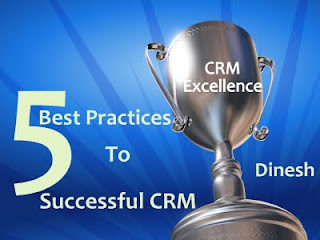 Dears,
Dears,Today millions of people remain out of work, the economy has clearly thawed and organizations are returning to investing customer-facing business process with a vengeance. The recent analyst report for global IT purchases of business software anticipates a healthy 9.7% increase in 2010, after brutal decline of 8.0% in 2009.
Based on our interaction with our customers and also from successful CRM practioners across the globe in different forums we understand the five fundamentals best practices were the keys to success before the economic meltdown — and they remain so today:
Best Practice No 1: Double efforts to increase user adoption. CRM initiatives can grind to halt when they run up against NIH (“not invented here”) attitudes of users who feel like they have not been consulted about their needs. A good example of how to bring users into the fold is a multi-national bank with over 3,000 CRM users that invited 84 users to participate directly in the CRM vendor selection decision. These users attended video conferences to review vendor solutions and then voted for the one that best fit their needs. This was followed by series of webinars where users from around the world viewed and critiqued prototype solutions developed by the CRM team. Finally, the end solution was tested in pilot programs in four different countries. This process built a strong user constituency who eagerly embraced the final solution.
Best Practice No. 2: Focus on underlying business processes. It is important to define the correct business processes before deciding on the technology that is most appropriate. For example, a water utility facing public criticism for its poor customer service formed a customer service process “re-engineering team” comprised representatives of all departments: clean water, waste water, customer service/call center, service contractors, IT and an external consultant. Once this team had completed its work of redesigning business processes, they sent an out an RFP to tender for a technology solution — and insisted that any software purchased fit their new process vision.
Best Practice No. 3: Rethink approach to executive sponsorship. Employees pay close attention to executive behavior, so it is important that senior leaders are visible in CRM initiatives. Senior managers at a High-tech firm wanted to improve customer satisfaction, and recognized that customer service reps were not effectively using a new CRM application to monitor and resolve customer problems. In a bold move, executives moved their desks to sit among customer service agents to better understand how they used the system and what steps needed to be taken to increase agent productivity to enhance customer service.
Best Practice No. 4: Reinvent customer data management capabilities. Inconsistent customer data from diverse sources is the Achilles Heel of CRM applications. A financial services organization was challenged by over 250 million customer records across diverse product lines. To achieve a true “360 degree” customer view, they implemented a program of data standardization across the lines of business. The company also implemented more robust customer data management tools to cleanse and de-duplicate their customer records prior to loading information into their CRM transaction systems. Access to “clean” and up-to-date customer information is now the foundation for executing more effective marketing campaigns.
Best Practice No. 5: Define and track the right metrics. Avoid vague and goals like “our company will become more customer-driven.” Define concrete measures to track you rate of success. For example, a global manufacturer decided the right measures for sales processes were: improving the prospect-to-sale conversion ratio and decreasing the length of the lead–to-order cycle time. For marketing, boosting campaign response rates and accelerating the lead maturation time (the time from when a customer shows interest, to the time they request a sales call) were most important.
Follow these 5 best Practice and you can rest assured that you are on the right track and soon there will be light at the end of the tunnel.
All the Best
Your Partner and Companion ( P&C)
DC*

No comments:
Post a Comment